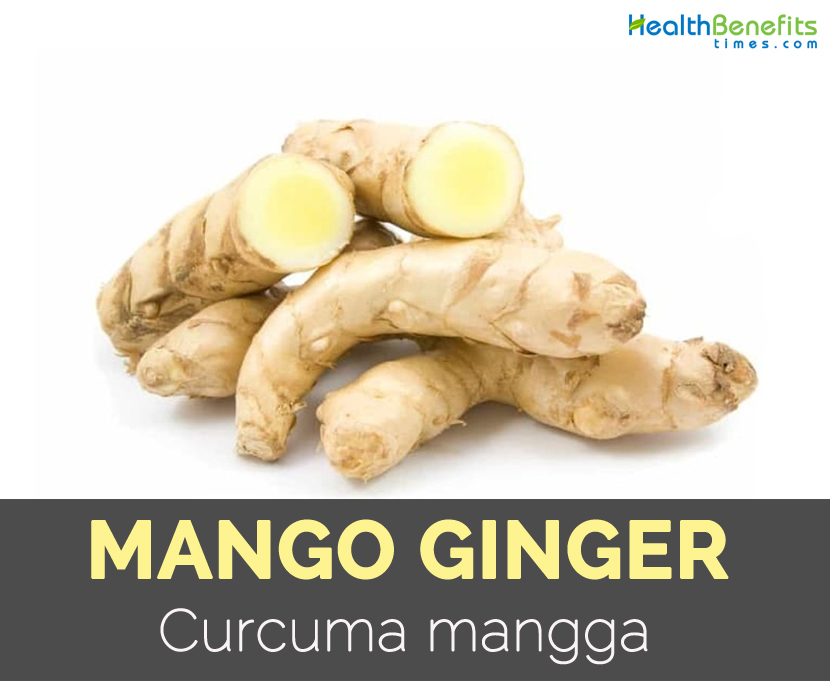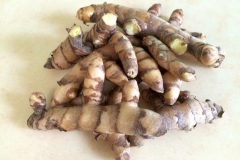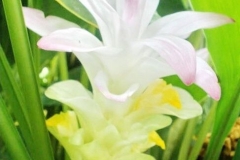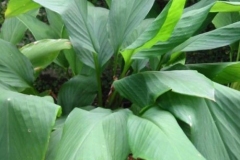Plant description
Mango Ginger is a tillering, erect and herbaceous perennial which measures 50 to 200 cm high with subterranean rhizome which is yellowish-brown outside, white at the top and citron yellow inside and smells like mango or kwini when crushed or sliced. Rhizome is globose or ellipsoid, lateral rhizomes are cylindrical or clavate, smaller and copiously branched. Stems are robust, erect having 2 to 4 scales or sheaths at the base and have 3 to 7 leaves higher. Leaf sheaths are conduplicate and 30 to 65 cm long. Leaf blades are elliptical oblong to oblong lanceolate measuring 15-95 cm by 5-23 cm and green with light or dark purple-brown along the midrib. An inflorescence is lateral i.e. flowering shoot terminal arises from lateral rhizome. Peduncle is slightly hairy, spike is cylindrical and measures 10–20 cm long having numerous leafy green bracts. Flower is slender having narrow throat. Labellum is obovate and 15-25 mm by 14-128 mm wide having yellow median band. Staminodes are white subelliptical and anther is long narrow spur.
Climate and soil
It prefers hot and humid tropical climate having high rainfall. It is found in open conditions but also tolerate low levels of shade. The cultivation is best for partially shaded portion. It grows well in sandy loam soil.
Health Benefits of Mango Ginger
1. Relieve pain
Mango ginger acts as a calming agent that provides relief from pain. Mix 25 grams of Curcuma manga with 100 grams of sesame and heat on low flame till it is lukewarm. Massage with this oil to relieve pain.
2. Treat skin diseases
Curcuma manga is used for treating skin problems. It detoxifies the body and improves skin complexion, skin problems and acne. It has antioxidant and antimicrobial activity. It treats skin issues. It detoxifies the body and improves skin complexion. It uses various cosmetics and skin care products. Add 2 tbsp of milk or rosewater and 2 tsp of mango ginger juice and apply it to face and leave for 20 minutes. Rinse with cold water.
3. Relieve Itching
The root is anti-allergenic and provides relief from itching. Combine 2 tsp of mango ginger juice to 2 tbsp of milk or rose water and coconut oil and apply it on irritated skin. Or mix 1 tsp of Mango ginger powder with a cup of milk. Boil and then cool before drinking.
4. Metabolic problems
The plant helps to rectify the metabolic problems. It soothes three Doshas in the body especially Pitta. It prevents the growth of triglycerides in the body which helps the metabolic complications. The mango ginger is helpful for those with diabetes. Mix a tablespoon of Mango ginger powder to a glass of milk before drinking.
5. Relieve Cold and Cough
Mango ginger is an analgesic and expectorant which is often used to provide relief from cold and cough. It provides relief from bronchitis and asthma. Mix teaspoon of dried Mango ginger powder with water or fresh juice. Drink this mixture to provide relief.
6. Relieve digestive problems
In human and animals, enterokinase found in Mango ginger assist digestion. The enzyme breaks down proteins to organic compounds which are easier to digest. Root also detoxifies the body. It provides relief from gas, promotes digestive strength and improves appetite.
7. Relieve inflammation
The anti-inflammatory properties prevent swelling in joints. It provides relief from swelling in liver, rheumatism, arthritic joint pains and swelling caused by injuries, bruises and sprains. Boil 200 gm of Moringa bark with water and make a paste. Combine this paste with 100 gm of Mango ginger powder and 100 gm of black pepper powder. Mix this together and apply it on joints to provide relief from pain.
8. Relieve head lice and dandruff
Mango ginger has anti-fungal and antimicrobial properties. Use it as a medication to provide relief from head lice and dandruff. Mix 10 grams each of mango ginger, Brahmi, fenugreek, Amla powder and 20 gm of Shikakai powder. Add it to 100 ml of coconut oil for forming a paste. Apply paste to scalp and let it remain for 30 minutes. Clean with herbal shampoo followed by conditioner.
Culinary uses
- In Indonesia, young shoots or young top rhizomes are consumed raw or cooked.
- Slice the rhizomes finely and mix with coconut to make trantjam.
- Inflorescence is cooked and consumed with rice.
- Rhizomes are used in South India for making pickles.
- It is used for decorating vegetables.
- It is used as a seasoning for foods.
- In north India, it is used to make chutneys and make pickles in South India.
- Rhizomes are consumed raw or boiled.
- Slice young rhizomes and cook it with coconut milk and chilli paste.
- Cook the flower clusters or steam and consume it with rice or use it in stews.
- Rhizomes are used to prepare chutney, pickles, candy, preserves, salad, sauce and in meat.
Medicinal use
- In Malaysia, rhizome is used for gastric ulcer, stomachic and also used for treating chest pains, general debility and to avoid womb healing.
- Starch in rhizome is helpful in treating abdominal illness.
- Treat the rhizomes mixture for fever and chew it to cause the womb to contract after childbirth.
- Consume the raw rhizome with rice to provide relief from flatulence, colic and stomachache.
- It is helpful for skin problems such as itching, redness and high continuous fever.
References:
https://pdfs.semanticscholar.org/1081/ec24176223face5ed3991f36c68d87e06ee4.pdf
https://en.wikipedia.org/wiki/Curcuma_amada
http://tropical.theferns.info/viewtropical.php?id=Curcuma+mangga
https://www.tarladalal.com/glossary-mango-ginger-1505i
https://www.chikitsa.com/medicinal-benefits-of-curcuma-amada
Comments
| Mango Ginger Quick Facts | |
|---|---|
| Name: | Mango Ginger |
| Scientific Name: | Curcuma mangga |
| Origin | The species is indigenous to Malesia and cultivated in Malaysia, Thailand and Indonesia. |
| Name | Mango Ginger |
|---|---|
| Scientific Name | Curcuma mangga |
| Native | The species is indigenous to Malesia and cultivated in Malaysia, Thailand and Indonesia. |
| Common/English Name | Mango Ginger, Mango Turmeric, Temu pauh, Kunyit mangga |
| Name in Other Languages | Malay: Temu pauh; Thai: Kha mîn khao; India: Manga Injee Indonesia:- Java: Temu Mangga, Temu Bajangan, Temu Poh, Temu Putih, Temu Lalab, Kunir Putih; Sundanese: Koneng Joho, Koneng Lalab, Koneng Pare, Madurese: Temmo Pao, Temmo Pote; Malaysia: Temu Pauh, Kunyt Mangga, Temu Mangga; Thailand: Khamin Khao |
| Plant Growth Habit | Erect, tillering, herbaceous perennial |
| Plant Size | 50-200 cm high |
| Leaf | 15–95 cm by 5–23 cm |





